You want to go hiking with your toddler, but you are worried that their little feet will get wet and cold if the conditions are muddy. Even if the conditions are sunny, there’s always the chance that they step into a stream or puddle.
Waterproof hiking boots seem like a good solution. But the truth is that your toddler does not need hiking boots or even waterproof hiking shoes. Here’s why and what they can wear instead.
Toddlers Shouldn’t Wear Hiking Boots
I stopped buying hiking boots for my kids a while back. They are expensive! This is particularly true for toddlers because their feet grow an average of ½ a size every three months. You’ll be lucky to get one season out of the boots. Getting outdoors shouldn’t be cost-prohibitive.
Even if you are okay spending money on hiking boots for your toddler, really little kids shouldn’t wear them for these reasons:
- The sole isn’t flexible. Experts like those at the College of Podiatry recommend that toddlers wear flexible shoes to aid in walking development.
- Boots are heavy for little legs. Put your toddler in boots and you’ll be hearing cries of “carry me” very soon!
- Toddlers can’t run or jump in bulky boots. Those boots which were supposed to “protect” them actually cause them to get hurt when they fall.
- It’s annoying to carry a toddler in boots. Almost all toddlers will need to be carried during some point of the hike. The boots make it hard to get them into a backpack carrier. In front carriers, the boots end up banging into you.
Also read: How Far Can Children Hike?
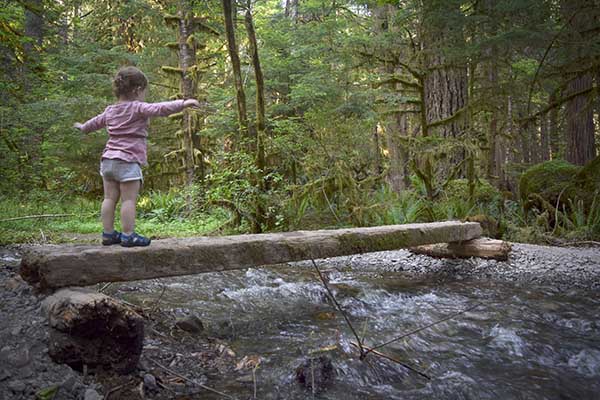
This is less scary because she’s wearing sandals. In boots, she’d be unstable and more likely to fall!
Hiking Shoes Are a Better Solution
In most cases, your toddler will be absolutely fine hiking in their everyday sneakers. If the trail is going to be very tough though, you might consider hiking shoes for your toddler.
Hiking shoes have the traction of a boot but, because they are low-top, they aren’t as heavy. Good brands will also make sure the sole is more flexible than an adult hiking shoe. It will be easier for your child to run and jump in them.
Toddler hiking shoes from good brands generally aren’t cheap though. :/ Unless you are very serious about hiking, they probably aren’t necessary.
The Shoes Don’t Need to Be Waterproof
Waterproof hiking shoes have an inner liner (such as Gore-Tex) which prevents water from getting into the interior of the shoe. The exterior of the shoe is made from a water-resistant material or has a coating on it.
The waterproofing will keep feet dry from light rain, small splashes and mud. This sounds great, but most hardcore hikers actually don’t like waterproof shoes.
Water can get in over the top: If your child steps in 3 inches of water, the water will enter the shoe from over the top and fill the shoes. So forget about letting your kid stand in muddy puddles while wearing waterproof shoes!
Once wet, waterproof shoes take forever to dry. The same technology that keeps water out will also trap water in. They can take hours to dry, and are heavier when wet because there’s no way for the water to exit. By comparison, non-waterproof hiking shoes or trail runners have lots of mesh areas where water will naturally drain out.
What Shoes Should My Toddler Wear when Hiking?
I repeat, your toddler is probably fine hiking in their everyday sneakers. If you are worried about their feet getting wet though, then hiking sandals (warm weather) or rubber boots (cold weather) are better than boots.
Hiking Sandals:
Not only are they the most comfortable option for your child. They have the benefit of drying very quickly so it’s not a big deal if your child gets them wet during water play. There are also rubber hiking sandals which can be worn in the water.
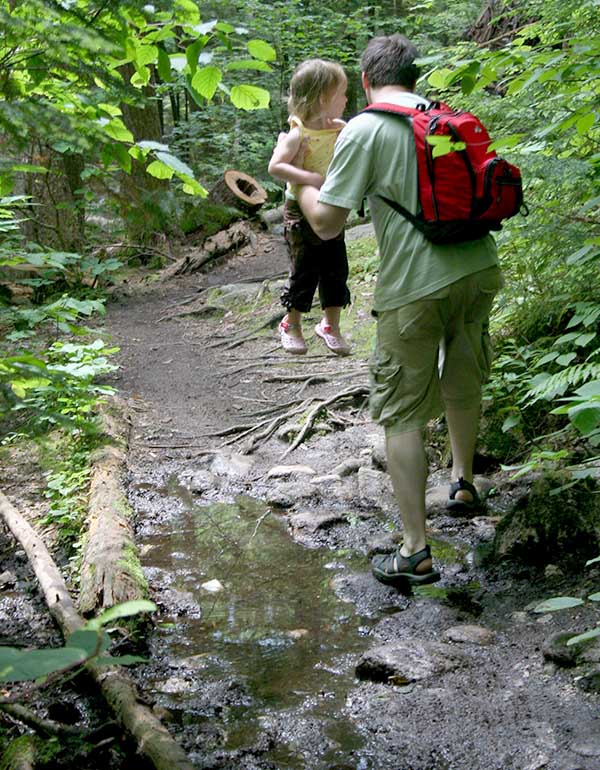
The Crocs are fine for the muddy trail but she still gets a ride over the puddle 🙂
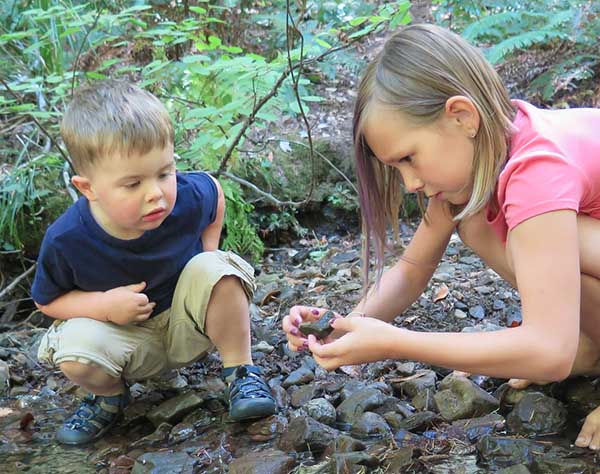
Hiking sandals dry quickly and are still comfortable to wear when wet. So no worries if this little guy gets his feet in the water!
Rubber Wellington Boots:
In colder temperatures or very muddy conditions, rubber boots are the only option which will actually keep your toddler’s feet dry.
The downside is that most cheap wellies are very heavy and clunky, so it’s hard for your child to hike in them. It will also be harder for you to get your toddler into a hiking carrier. The brands Bogs, Jan & Jul, and Oaki make fantastic lightweight rain boots for toddlers, but damn are they expensive! At least they are useful outside of just hiking though. There are also these budget picks.
Also read: Best Rain Suits for Toddlers
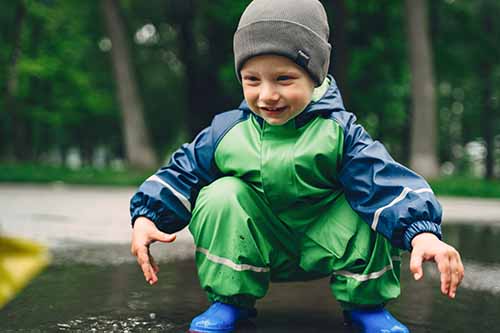
Pro Tips
1. Get Hiking Socks for Your Toddler
Unlike cotton socks which absorb water, hiking socks wick moisture from the feet. This way, if your child’s shoes get wet, it won’t be as big of a deal as if they were wearing cotton socks. And guess what? Hiking socks are a lot cheaper than hiking shoes for toddlers!
2. Have a Change of Shoes and Socks in the Car
If driving to your hike, make sure you have a change of footwear in the car. Then your toddler will have something comfy and dry to put on for the trip back.
Resources:
https://www.ncbi.nlm.nih.gov/pmc/articles/PMC2661351/,
https://www.nct.org.uk/baby-toddler/your-childs-development/12-18-months/when-and-how-select-toddler-shoes,
static/file/Children's_FootHealth.pdf,
https://www.betterhealth.vic.gov.au/health/healthyliving/childrens-feet-and-shoes,
https://www.outsideonline.com/outdoor-gear/hiking-gear/which-hiking-boots-will-keep-me-dry-during-stre-crossings/
Image credits:
“nick eating an apple on a mossy log – _M” (CC BY-NC-SA 2.0) by sean dreilinger
“IMG_4496” (CC BY 2.0) by abbybatchelder,
“Happy Baby on the Trail” (CC BY-NC 2.0) by Nickay3111,
“IMG_4477” (CC BY 2.0) by abbybatchelder,
“hiker” (CC BY-NC-SA 2.0) by CaZen ,


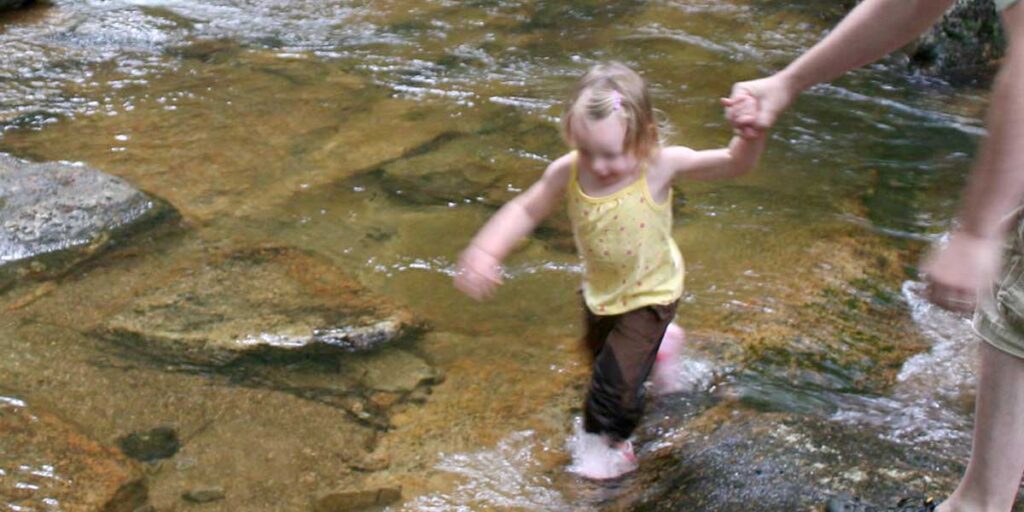
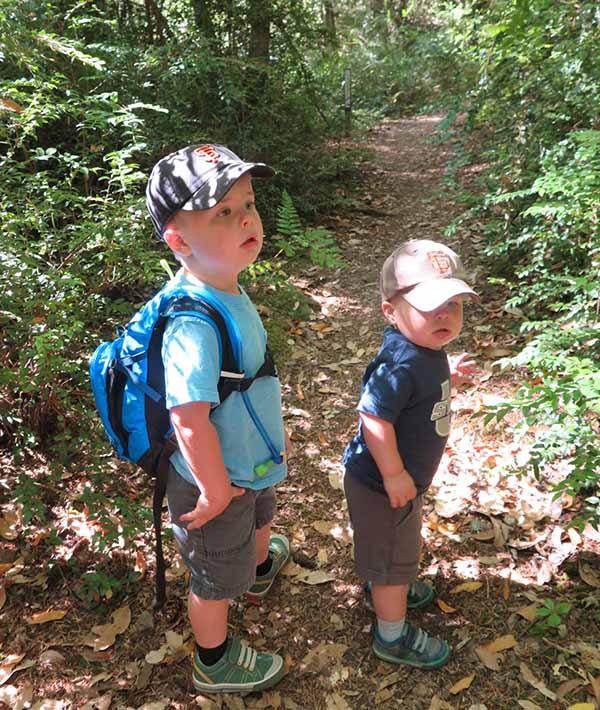
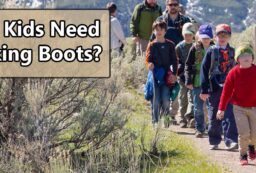
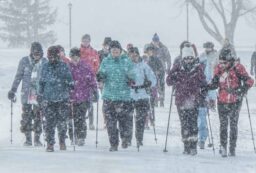








Post your comments